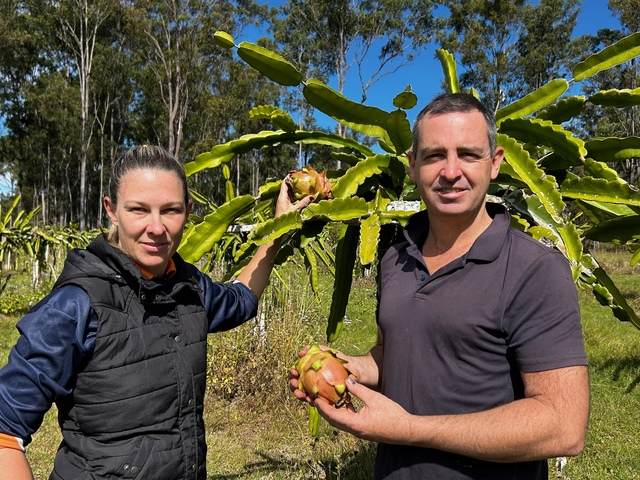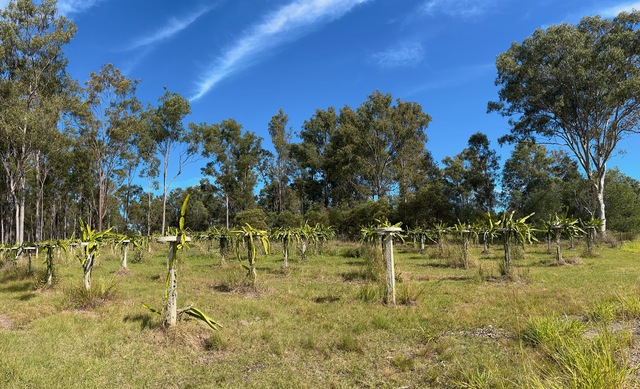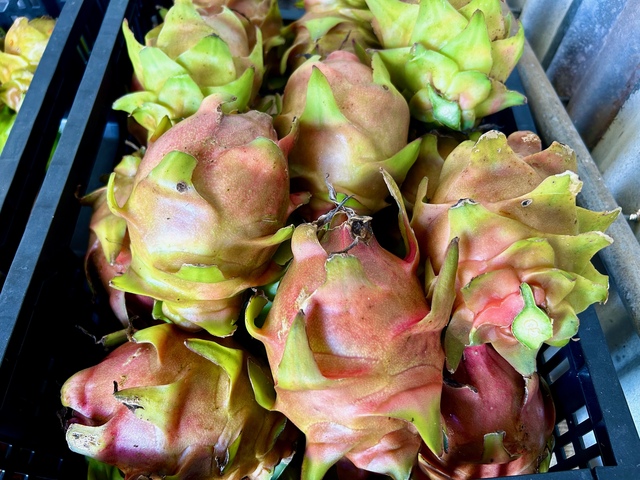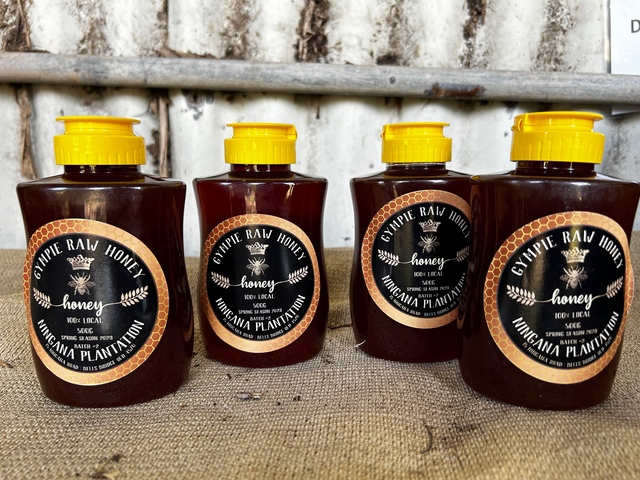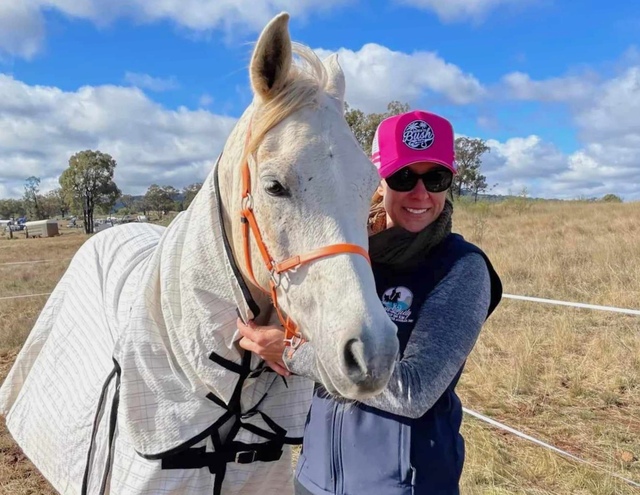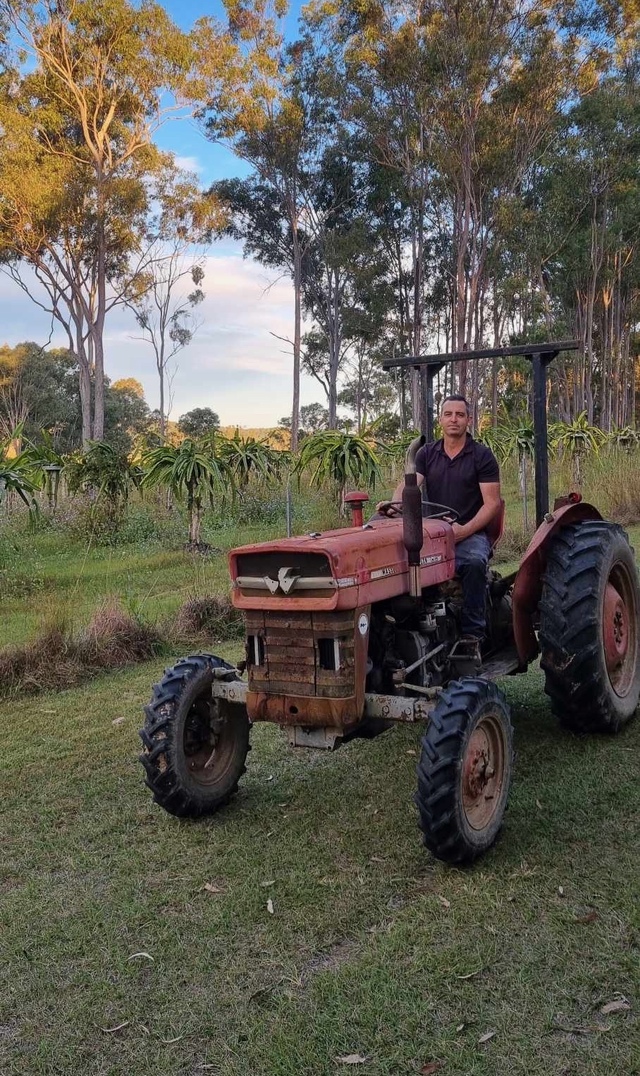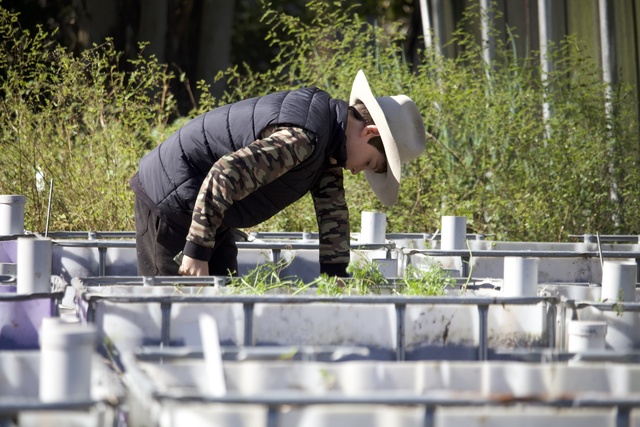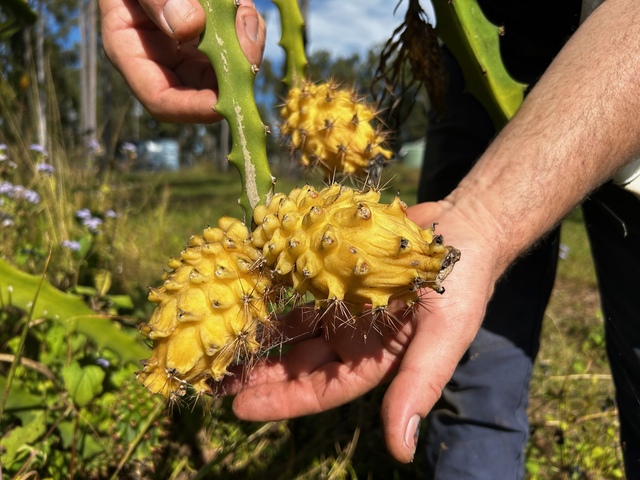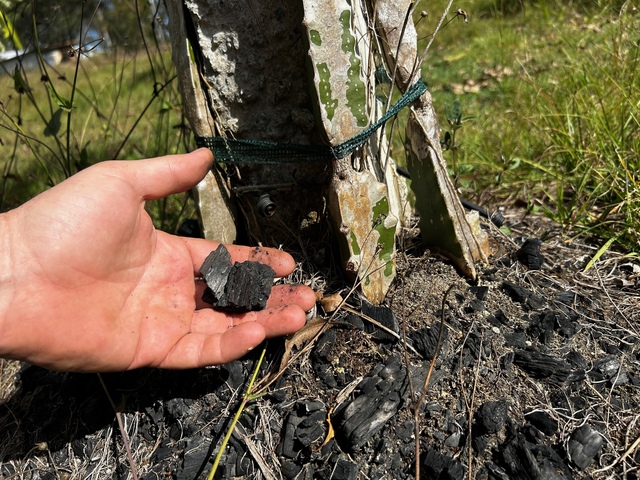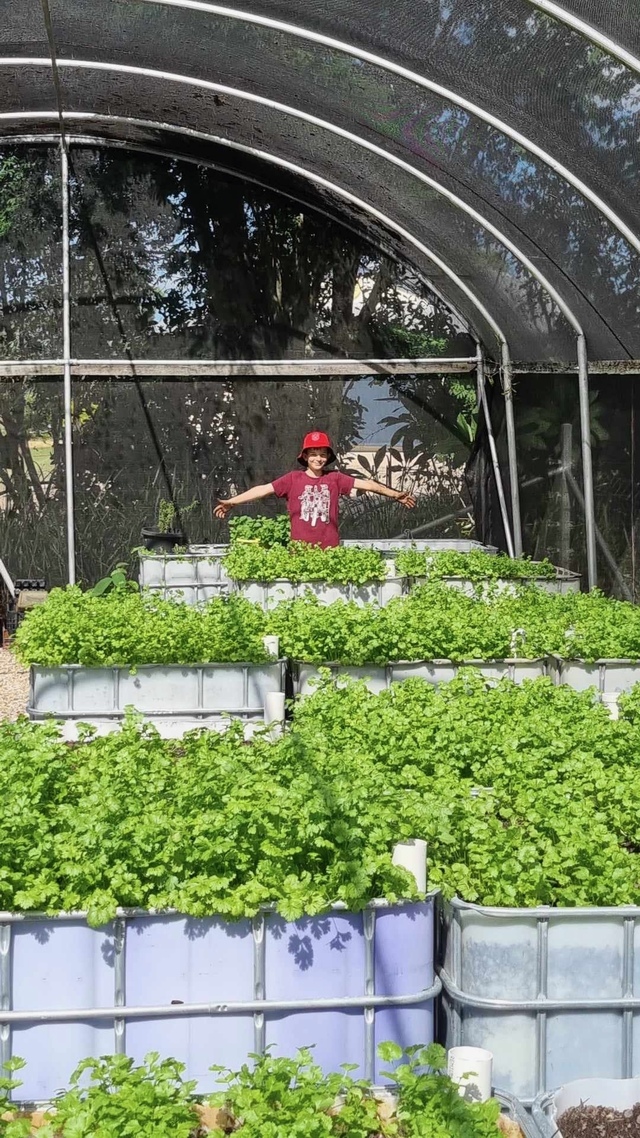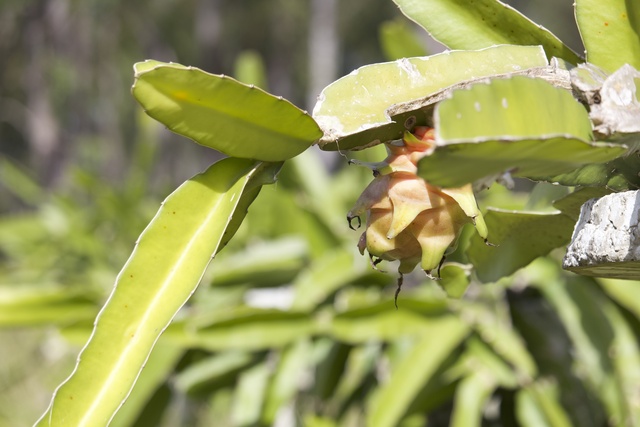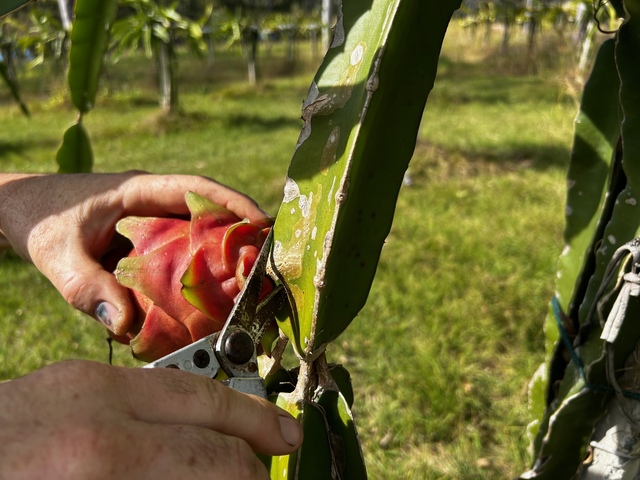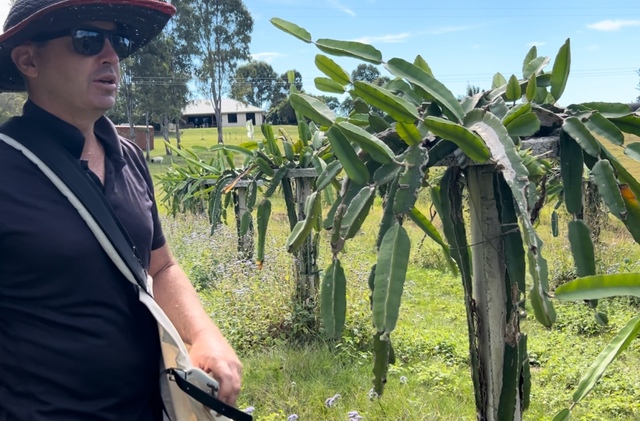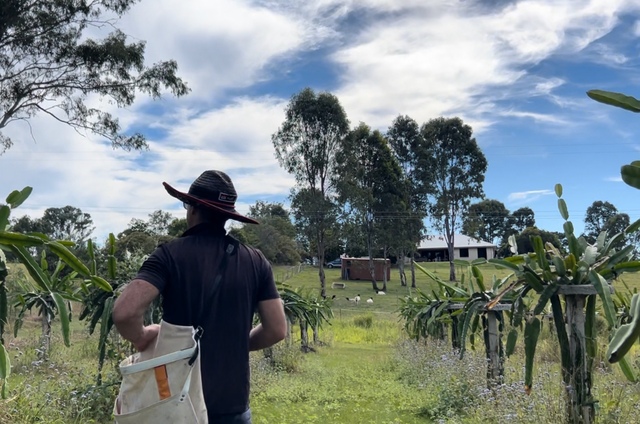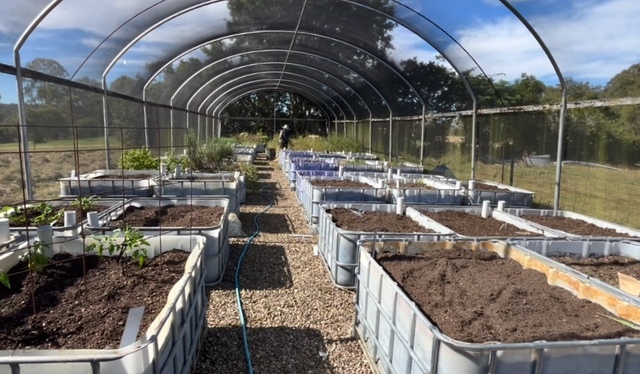Balancing work and life can be hard, especially with the demands of the modern world.
Yet for Bruce and Sherry Lowe it is easier because they both do what they love – whether that be at work or at home.
Both grew up in the Mary Valley and now live and work in the area every day – except when Sherry’s role as general manager of the Mary Valley Rattler calls her away to promote not just the heritage tourist train but the wider Gympie region.
Yet again, it’s something she is passionate about.
Just like their property at Bells Bridge – which is where I find them on a Sunday morning.
It needed to be Sunday due to Sherry’s other commitments, particularly endurance horse riding.
That is Sherry’s way of putting work into perspective – just her, the horse and riding through such a beautiful landscape as the Australian bush.
Our catch-up needed to be before the end of June as the dragonfruit crop was almost finished for the season.
Bruce has been balancing getting the fruit off the vines with his work as a mobile mechanic, mainly for farm machinery.
Ningana is a 16-acre property the family use as a combination of grazing land, orchards and for a tunnel shelter to grow herbs and vegetables.
They grow dragonfruit, harvest honey, herbs and vegetables, as well as keeping a small flock of sheep.
The property is predominantly north-south with the slope to the north-east, and a dam in the valley.
There are about 200 posts for the dragonfruit – with four vines on each.
Most are planted on the north-east slope with some across the dam, amongst eucalyptus trees for filtered light.
Dragonfruit use aerial roots to climb up large posts or tree trunks, and they get moisture from the air.
Bruce designed the posts for their orchard – made from concrete so as to get four vines to a post.
He was introduced to the fruit by his father Henry, who was growing a few at his home.
“I always had an interest in it. We’ve always wanted to get into some sort of farming and this ticks a few boxes.
“You don’t need highly fertile soil, they’re quite drought resistant.’’
Sherry said they ended up planting around the post so that they get the nutrients they need.
“It’s all drip irrigation throughout the property from the dam.
“We were trying to mulch once a year and feed the plants minerals as needed. The mulches include wood-chip or sugarcane, together with biochar to put carbon back into the soil – that increases the micro-biology as well.’’
Bruce and Sherry are growing a few different varieties but mainly commercial reds, a red flesh variety – and some megalanthus. These are the yellow ones with white flesh and lemonade flavour.
The yellow dragonfruit are the rarest seen in Australia – and the Ningana fruit took out first place this year at the Gympie Show.
The curiosity about dragonfruit is that in many shops they are not labelled red or white flesh.
“You might be able to see it on the box that they are delivered in,’’ Bruce said.
“They make an amazing dessert – this brilliant red with ice cream. It just looks great.’’
The fruit is high in fibre and antioxidants, Sherry said.
“It’s a very refreshing fruit because of the moisture content. It must be served chilled.
“There are a few other varieties we’ve been experimenting with as well.
“They taste something like a kiwi fruit with a pear texture.’’
Sherry picks a red fruit from a vine and explains how it is starting to blush.
“You can see the red tinge.
“We need to pick it before the birds get into them. Just store it a little bit more on the bench and then pop it in the fridge.’’
To harvest the fruit, Bruce and Sherry use special cutters – not secateurs but precision pruners that are sharp on the end. This is so that you’re cutting a bit of the vine as well, otherwise the spikes on the plant will damage your arms.
Each of the little nodes forming on the vine will form a fruit but not all in the one season. They can self-regulate and limit the amount of fruit they bear.
Bruce and Sherry have been at Bells Bridge 15 years and planted the dragonfruit four-to-five years ago.
“We originally fenced to graze sheep and have done a lot to improve the soil,’’ Sherry said.
“It has been forest soil. We put a lot of effort into the microbiology by increasing plant matter. Bruce makes all the biochar on the farm.’’
Biochar is the carbon and ash remaining after the heating of biomass, and is a form of charcoal.
For Bruce, the biochar is like a little hotel for microbes.
“Each canal in that biochar is an opportunity for microbes to lodge in there. It’s protection for them.’’
There have been lessons learned along the journey of growing dragonfruit – and surprises too.
“We know they don’t like long periods of cold weather,’’ Bruce said. “There was some die-back a couple of years ago from that.
“It was a wet winter.’’
Among the surprises have been finding that when the plant is stressed from hot, dry weather they tend to produce more fruit.
“A few years ago we had a long stretch of dry weather and they produced well, but the past couple of years there’s been more rain.
“Three years ago, we had the best yield. That year we were picking 500 fruit every second day.
“The more consistent rain the vines get, the more growth.’’
There is nothing more satisfying than to go for wonder of a nice afternoon and pick a few crates of dragonfruit, Bruce said.
The vines have a queen-of-the-night style flower, Sherry added.
“It comes out for one night, usually on a full moon, and 35 days later we have a fruit to pick.
“This was always our retirement plan, to get this orchard up and going – they don’t take much to care for and they’ll be here for decades.
“For us, that was the appeal. We can slowly grow the orchard as a farm together.
“It’s not intense labour for us. The kids like to get amongst it as well.’’
The dragonfruit do suffer at times with insect damage from the heliothis moth.
“The caterpillar will tunnel its way into the fruit,’’ Bruce said, “so we’ve had some losses with that.
“We don’t use chemicals – if we have a few losses it’s just nature’s way.’’
Bruce and Sherry’s philosophy is that everything stays on the farm.
“The pig loves the fruit,’’ Sherry said, “so nothing goes to waste.
“The pig takes care of everything.’’
For Bruce, he didn’t plan on growing dragonfruit as their main form of income.
“I’ve always wanted to do it but was just going to establish it and see how we went.
“It was going to be an interest rather than my income.’’
Bruce grew up in The Dawn area, while Sherry is originally from Imbil.
A Valentine’s Day train trip to Kandanga for lunch on the original Mary Valley Heritage Railway highlighted their love of the region and, while they didn’t realise it then, this affinity with trains would lead to Sherry’s career move with the Mary Valley Rattler instead of as a physical education (PE) teacher.
Bruce started as an apprentice at Madills Motors in Gympie, and over the past 25 years moved into trucks and tractors, semi-trailers and motorcycles.
“I’ve got a bit of a broad farm basis of knowledge, so when I started my own mobile mechanical business I could take on most things.’’
For Sherry, endurance riding adds to achieving a perfect work-life balance.
Having started riding while at primary school, she joined the Imbil Forest Endurance Club.
Her first Australian Endurance Riders Association (AERA) ride was in 1999. That was at Rosedale where she won the junior section of the 80km event.
More recently Sherry won line honours and first middleweight in the 80km event at EnduraFest, held at Inglewood.
“That has been my greatest sporting career highlight … together with achieving a buckle for completion of the 160km course at the 2022 Tom Quilty Gold Cup at Tooraweenah in New South Wales.
“This for me is, if you talk about work-life balance, gives me that. Some have a gym membership, others go on a park run, or spend time with friends.
“With endurance riding it’s something you can share with family and friends.
“Endurance is a family sport. To complete is to win … but it’s more about the horse’s journey than mine.
“It’s about putting extra work into this horse – to grow him. The state championships are at Widgee later this month and I have set my sights on that. After all, it’s right in our back yard.’’
This balancing of life with work through having the farm is important because they are both so busy.
“It’s good to be busy,’’ Bruce said. “The farm is central for our work.
“When we bought the property we wanted to be far out of town enough to get a substantial amount of land that we could actually utilise.
“It was a bit tricky in the beginning to find some land flat enough, yet with some water and within our budget – we ended up putting some roots down here.’’
This was bare land, Sherry said, and there is still some remnant vegetation.
“So everything you see here is how we built it up ourselves – the house, the sheds and the fencing.
“That’s been very rewarding.
“We wanted something to grow among gum trees and there are not many orchards you can do that with.
“We thought we’d give it a go and it’s actually worked out.
“These plants are tolerant of shade – they don’t mind it. The foliage can get burnt in the heat of summer whereas having some vines among the trees get that afternoon shade and only a few hours of intensive sunlight.
“They do better as they’re a rainforest jungle plant from Central and South America.
“They are a canopy plant so they’re heading for the light. In the wild they climb up a host tree.
“It’s almost companion planting.’’
Initially the plan was to have the sheep graze among the vines to keep the grass down but they started nipping the buds off the vines.
Now it’s a matter of whipper-snippering among the rows.
As for the sheep, there are about a dozen dorpers in the flock.
“You get the stocky body weight from the dorset and the grazing type habit from the black Persian,’’ Sherry said.
“We even had a baby lamb this morning.’’
As we make our way up to the shade tunnel Sherry said they have had coriander and radish growing for market and Brisbane restaurants.
But this season it’s mainly just stuff for the home, such as planting some tomatoes for a winter crop – without the insects of summer.
The wicking beds comprise of gravel on agricultural pipe, then geo mesh and soil on top. Water is fed into the base so soil will not get stodgy.
“They are good for us in any inclement weather,’’ Sherry said. “When it gets really dry, we are not relying on the sub-soil to provide the moisture. We can mediate that.
“The best part is you get straight carrots, celery, radishes … the root crops do really well.
“It’s always good to find a market before you put stuff in the ground.’’
There are so many advantages of this style of farming, Bruce said.
“You cannot have it on a broad scale but having the crops in the tunnel, it is a controlled environment.’’
Up at the farm stall, Sherry explains how collecting honey was a natural step for her.
“Obviously the bees play their part, being dotted around the farm. They pollinate the plants and take some back to the hive.
“They create that really healthy ecology.
“Here on the farm we have something to eat and something to sell.
“Without bees, we don’t have life. We are so lucky to be able to share what nature has provided.’’
Sherry’s initial interest came from father-in-law Henry and brother-in-law Andy.
“They are right into bees. Andy has Holistic Hives.
“I got interested in bees and the benefits of having them.
“It started with a Flow Hive six or seven years ago and then one went to two. Now I have a bunch in the front garden and also down near the dragonfruit.’’
Selling it in squeeze bottles means there is no need to scoop the honey out of a jar with a metal spoon.
“There’s not a distinctive taste to the honey, but there will be dragonfruit as well as the eucalypt trees,’’ Sherry said. “The native wattle is out of the moment.’’
“You tell the difference between whether the bees have obtained the pollen from the gum blossoms or the wattle.’’
For Bruce, an important aspect of growing something on your property is about teaching the next generation that they can provide for themselves and others in the community.
Meanwhile Sherry enjoys the selling and swapping of produce.
“We have the farm shop where people can stop and take the opportunity to get fresh dragonfruit or honey right from the farm gate – with no extra handling, no middle man.
“They can get it as fresh as it can be … that’s fulfilling for us. It’s significantly cheaper than commercial supermarkets.
“That money can go back into the farm and the fruit.’’
Something Bruce is proud of is the role they play in promoting the region – no matter how big or small.
“If someone is going for a day trip out to the Bunyas or whatever, they can stop off at farm shops on the way.
“There are people always stopping in. A lady gets our fruit for making ice cream and there are others who take it to market.
“It’s not high in sugar, so people with blood sugar issues can enjoy it.
“I’ve seen a dragonfruit sorbet at Sunshine Plaza – a beautiful iridescent pink dragonfruit sorbet with lychee.’’
Dragonfruit are good in smoothies and yoghurt, Sherry said, because of the colour and nutritional value.
“At the heart of it,’’ Bruce said, “is the fact you are producing something of value, something you can share, something that has goodness in it.
“You know where it’s come from – off your own property. And you get a lot of satisfaction from that, knowing you can play a part in your community, with your neighbours and people in your area.
“You become known as the bee man, the dragonfruit man or the mandarin man … it comes back to not having to do everything, but if you can do something well, then you can exchange that and everyone is a winner.
“You don’t have to be self-sufficient but you can play a part in making the region self-sufficient.
“Everyone is going to have their niche product. Not everyone can be expected to have everything.’’
There’s a lesson here for us all. As many people learned during the pandemic, it can be incredibly rewarding to grow your own produce and know the origin and history of your food. Bruce and Sherry are chasing their dream, and in doing so have brought a nutritious product to their local market that others can enjoy.

